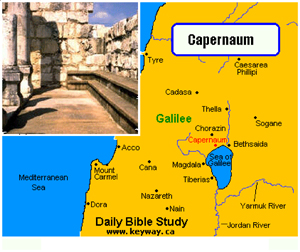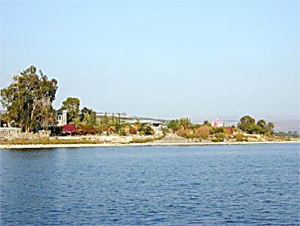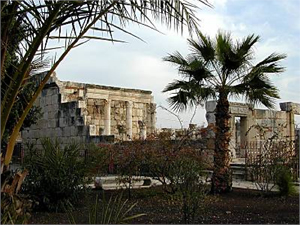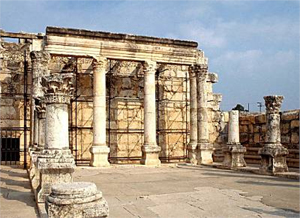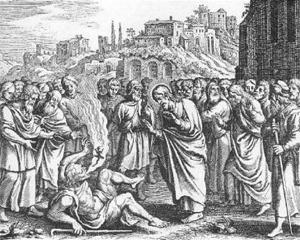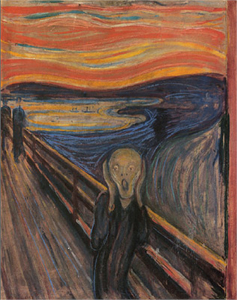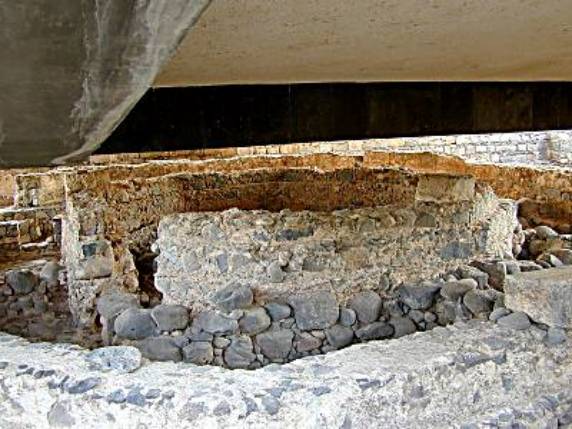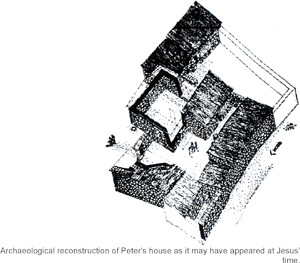
Christmas
Easter
Pentcoest
All Saints
Christ The King
Confirmation
Palm/Passion
Reformation
Stewardship
Books of the Bible
Lenten Series
Christmas Dramas
Videos
Series A - Matthew
Series B - Mark
Series C - Luke
Series D - Other
To contact
Edward F. Markquart
info@sfs.com
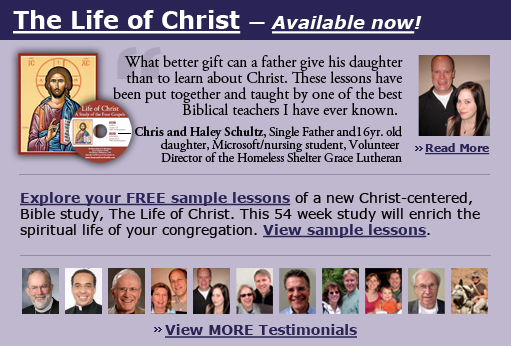
Series B Gospel Lesson for Epiphany 4B: Mark 1:21-28 An Unclean Spirit Gospel Lesson for Epiphany 5B: Mark 1:29-39 A Fever Gospel Lesson for Epiphany 6B: Mark 1:40-45 Leprosy Gospel Lesson for Epiphany 7B: Mark 2:1-12 Paralysis There could be four consecutive sermons on healing. Each sermon could have a different emphasis.
Pastor Edward F. Markquart The following Bible study is from a larger course entitled, THE LIFE OF CHRIST: A Study in the Four Gospels. This 54 week course for the laity will be available for congregations in 2006. Basic text for the course: SYNOPSIS OF THE FOUR GOSPELS, Kurt Aland, English Edition, P. 34-35.
THOUGHTS ABOUT THE HEALING MIRACLES OF JESUS According to the gospels, Jesus was involved in sixteen healing miracles. God, through Jesus and the power of faith, healed sixteen people during Jesus' lifetime here on earth. The Gospel of Mark records ten consecutive incidents at the beginning of his gospel. These healings were signs that the reign of God was present. The first of Jesus' healing miracles is the gospel story for today, the healing of a man with an unclean spirit. It appears this miracle involved the serious issue of "demon possession." The second of Jesus's healing miracles is the gospel story for next week, the healing of Peter's mother-in-law of her fever. It appears that this miracle involved a "not so serious illness" of a common and ordinary fever. Every normal person wants to be well, physically and emotionally. That was true in Jesus’ day; and that is true also today. Mental and physical health has always been crucially important to human beings. Health and healings are signs of the Presence of God and the kingdom of God. When people, societies, and nations are healthy, that is good. Their health is a sign that the Presence of God is with them. But the issue is more complex than that. We also find that God is present during times of illness, suffering, and disease. In the deep valleys and shadows of death and dying, we also find the Presence of God. In fact, when we are suffering the most, God is with us. Even so, a sign of the kingdom of God is when evil and the demonic are eradicated. Every century and civilization formulates their own understanding of diseases, their causes and their cures. Every generation and geography of the world has its own particular diseases that are of primary concern. In the Biblical days of the New Testament, it was blindness, leprosy and lameness. In the modern days of today, our society is concerned about cancer, heart attacks, and alcohol/drug addictions. The new plague and pandemic in today's world is AIDs. The people of the New Testament generation did not have concepts of viruses, germs, heredity, and environment factors that contribute to the cause of diseases. The New Testament generation simply believed that “sin,” “demons” and “evil spirits” caused diseases. The Old and New Testaments were written in a pre-scientific age. Regardless of century, diseases and illnesses have been regarded as undesirable and evil. People of every generation work at getting rid of those illnesses. A high percentage of diseases have always been caused by sinful behaviors and attitudes, by dispositions of the mind and actions of the body. Studies today conclude that 85% of all illnesses that physicians see today are caused by psychological attitudes. One study about cancer prone mice put those mice into a laboratory test. One group of cancer prone mice had enormous stress put on them; the second group was stress free. 92% of the first group of "stressed mice" developed cancer; 7% of the second group of "stress-free mice" developed cancer. Stress in mice affected their immune systems at a 92% rate. In other words, people today are well aware that stress and psychological “dis-eases” contribute to physiological diseases. Stress can contribute to cancer. So can unhealthy habits and sinful behaviors. Larger corporations in the Unites States are now attempting to fire people who are addicted to smoking because smoking signficantly increases the risk of cancer and also the costs of health care in combating that cancer. Also, if companies pollute a river with waste that contains carcinogens, people living near that river will have a higher incidence of cancer. Likewise, people will have a higher rate of cancer if they live with asbestos in their homes, live near an aging smokestack, or live near a company that has been polluting the environment. The higher rate of cancer in those situations will be a symptom of sinful decisions and behaviors permeating the environment in which people live. Many people, then and now, often ask the question when they or their loved ones are sick: “Why is God punishing us?” Illness is often seen as a punishment from God. In the Bible, we remember the question: “Is this man blind because his parents sinned or because he sinned?” Many people intuitively and erroneously believe that all illness is simply a consequence of sin, an evidence of sinful consequences. The Book of Job was written to counter this simplistic conclusion. That is, there are illnesses which are a result of sinful and foolish behaviors; there are also illnesses which are not the result of sinful and foolish behaviors. It is not simply true that all illness is God’s punishment for sinful behavior. The healing miracles of Jesus have inspired the church in every century to be engaged in the art and science of healing as evidence of the reign of God. Doctors and nurses today are still drawn to the medical professions as a way of helping people. Hospitals are often named after religious figures. Jesus came to heal diseases and his followers of every century have done the same. Healing of diseases is a sign that the reign of God is present. It was a sign two thousand years ago and it is still a sign today. Wherever there is healing and health, there is the presence of God. DISCUSSION QUESTION: HOW HAVE YOU EXPERIENCED GOD’S HEALING IN YOUR LIFE? GIVE SPECIFIC EXAMPLES
The following is the gospel text for Epiphany 4B:
#35. TEACHING IN THE SYNAGOGUE AT CAPERNAUM Matthew 4:13 Mark 1:21-22, Luke 4:31-32, John 2:12 -They went to Capernaum; and when the Sabbath came, he entered the synagogue and taught. Capernaum was Jesus’ hometown in adulthood. Focus on Matthew 4:13. Underline the word, “dwelt” or “lived” in Capernaum. Capernaum was Jesus’ hometown of adulthood. http://www.execulink.com/~wblank/20020117.htm
http://www.christiananswers.net/bibleplaces/home.html View from the Sea. Jesus made Capernaum his home during the years of his ministry: "Leaving Nazareth he went and lived in Capernaum" (Matt 4:13). Peter, Andrew, James and John were fishermen living in the village. Matthew the tax collector also dwelt here. Capernaum was one of the three cities cursed by Jesus for its lack of faith.
http://www.gnmagazine.org/issues/gn25/archaeologyministry.htm “Their soil," wrote the Jewish historian Josephus, "is universally rich and fruitful, and full of the plantations of trees of all sorts, insomuch that it invites, by its fruitfulness, the most slothful to take pains in its cultivation. Accordingly it is all cultivated by its inhabitants, and no part lies idle" (Wars of the Jews, Book III, Chapter III, Section 2). Jesus drew many of His parables and illustrations from daily life and activities around the lake. The site of Capernaum, which means "village of Nahum," was identified in 1838 and was extensively excavated during this century. What have archaeologists found? John Laughlin, professor of religion at Averett College,Danville, VA., participated in excavations at Capernaum. He comments: "What is known indicates that at this time Capernaum was a small village located on the shore of the Sea of Galilee with a population of probably no more than 1,000 people. The few architectural remains indicate the buildings were spacious and well constructed of dressed stones and large amounts of plaster. This suggests that the village flourished economically during Jesus' time. Its location on the crossroads of important trade routes, the fertile lands surrounding it and the rich fishing available all contributed to its economic development" (Biblical Archaeological Review, September-October 1993, p. 59)." Circle the four gospel parallels of the word, “synagogue.” It was a pattern of Jesus (and later the Apostle Paul) to visit a local synagogue for Friday evening synagogue worship (on the eve of the Sabbath.) In the synagogue, Jesus was confronted by a demoniac while teaching here (Mark 1:21-27). In Capernaum, Jesus healed the centurion's servant, who built the synagogue (Luke 7:3).In the synagogue at Capernaum, Jesus gave sermon on the bread of life (John 6:35-59). -They were astounded at his teaching, for he taught them as one having authority, and not as the scribes. #36 HEALING OF THE DEMONIC IN THE SYNAGOGUE Mark 1:23-28, Luke 4:33-37 Notice the almost exact parallels in Mark and Luke. We know that Luke copied about 50% of Mark and here is an example of Luke copying Mark almost word for word. Notice that these verses are not from Q. Q occurs whenever Matthew and Luke have nearly identical wording or a nearly identical sequence of thought. The two gospels readings in this section are from Mark and Luke, not Matthew and Luke. -Just then there was in their synagogue a man with an unclean spirit,
The exact dating of the synagogue pictured above is questionable, but it was clearly constructed later than the first century after Christ. Excavations of this synagogue reveal that the base of the walls were from the time of Christ. The base of the walls was made of chiseled stone and is four feet thick. There was a man sick with an unclean spirit. The person who was sick is incidental to the story; the focus of attention is on this unclean spirit. The people of that New Testament era believed that there were unclean spirits or demons living inside of people that caused diseases. Circle the words, “unclean spirit.” We also are aware of unclean spirits living inside of us today, some two thousand years later. An explosion of anger. A suicidal impulse. An intense jealousy. A wild sexual fantasy. An overwhelming feeling of depression and dream. We, as human beings, are keenly aware of these unclean spirits in our hearts and inner thoughts. We often wonder where these “unclean thoughts” come from and why we can’t get rid of them. It is as if they are part of our inner nature as a human being. We as human beings occasionally wonder why we can't get rid of these "unclean spirits" that seem to perpetually live within us. -And he cried out, "What have you to do with us, Jesus of Nazareth? Have you come to destroy us? Highlight. This is a persistent question for us today as well. That is, we ask, “What does Jesus have to do with these unclean spirits that live in each one of us?” The answer is equally true today: Jesus came to destroy the unclean spirits living inside of us. That is one of the reasons that Jesus came to earth in the first place and one the reasons that he comes to our lives as well. Jesus came to drive out those unclean spirits within us, to wash them away, to cleanse our lives of them. -I know who you are, the Holy One of God." Highlight. The evil spirits knew the true identity of Jesus. Jesus was the Holy One of God, the Son of God. Jesus, himself, did not want his full identity revealed just yet. Jesus wanted people to find out for themselves who he really was. The demons knew. The evil spirits knew. But people had to discover for themselves the true identity of Jesus. -But Jesus rebuked him, saying, "Be silent, and come out of him!" Highlight. Jesus commands the evil spirit harshly, using strong words and tones. We find this pattern in several demon possession stories. This is one of the reasons that Jesus developed a reputation for speaking with authority. -And the unclean spirit, convulsing him and crying with a loud voice, came out of him. This demon caused convulsions and cried out with an audible voice. It is clear that is this particular story is about demon possession. http://www.biblical-art.com/artwork.asp?id_artwork=10934&showmode=Full Merian, Matthaeus the Elder, Swiss, 1625-30
What do you see in the above painting? Fire from the man's mouth? A lizard coming out of the demon possessed man? People pointing and asking questions? You see a village that looks like a Swiss village from the seventeenth century. You see the crowd watching this event. -They were all amazed, and they kept on asking one another, "What is this? A new teaching—with authority (and power)! He commands even the unclean spirits, and they obey him." With authority. Highlight. Jesus speaks with a new authority and even the unclean spirits obey him. Later, we shall see Jesus rebuke the waters of a wind-whipped lake and calm the evil spirit in the waters. Jesus demonstrated again and again his inner spiritual strength. God’s power, wisdom and insight lived within him. The result was that Jesus spoke with authority on many occasions and healed many people. There seems to be a distinction between people who were “sick” and people who were “demon possessed.” Also see Mark 1:34 and highlight: “He healed many who were sick with various diseases and cast out many demons.” Demon possession was a form of mental illness during Biblical times. Demon possession and fear of demons was part of the ancient Biblical world e.g. there was a blindness demon, a leprosy demon, a lameness demon, etc. The people of the ancient Biblical era lived in a world permeated with demons and evil spirits. In this course, “demon possession” will be treated as a form of mental illness/emotional disturbance. A modern painting that symbolizes emotional madness is entitled, The Scream. http://www.edvard-munch.com/Paintings/anxiety/scream_3.jpg Edvard Munch, The Scream Dr. William Barclay, in his commentary on this text, tells about “trepanning” in the ancient medical world. “Trepanning” was a primitive surgical procedure in which a hole was drilled in a human skull to release the demons inside the skull. Six of more than one hundred skulls found in an ancient cemetery had experienced “trepanning.” We often forget how people with mental illness were treated here in America before drugs were available for their treatment. Before the advent of drugs to control mentally ill people, there were chains attached to the floor of the “insane asylum” like at Hastings State Hospital in Hastings, Minnesota. I worked at Hastings State Mental Hospital as a student-chaplain so many years ago. In the “old days,” prior to drugs, mentally ill patients were chained to the basement walls in this facility, near a cement trench, in which the mentally ill patients could urinate and defecate. The advent of new drugs enabled these people to become freed from their physical chains and even live lives outside of the “insane asylum.” We sometimes forget how the emotionally disturbed were treated in our society before the advent of miracle drugs. Through the advent of “miracle drugs,” the behaviors and language of emotionally unstable people were controlled and these people were released out into normal society. “And power.” Only in Luke. Highlight. Luke consistently talks about the power of the Holy Spirit, the power of Jesus, and the power that will be bestowed on all Christians to speak boldly about Jesus Christ. The word, “power,” is central to Luke’s theology. We recall in Luke 4:14 (p. 28) “Jesus returned in the power of the Holy Spirit into Galilee.” In that passage, only Luke emphasized that Jesus returned “in the power of the Holy Spirit.” In Acts 1:8, we recall that “You will be filled with power when the Holy Spirit comes upon you.” Luke uses the word, “power,” seventeen times in his the Gospel of Luke and eleven times in Acts. The power that lived in Jesus, raised Jesus from the dead and filled the first disciples was available to the church in ancient times and is still available to us today. -At once his fame began to spread throughout the surrounding region of Galilee. Yes, in the future, we are going to see Jesus confronting his new fame which began to grow and grow until thousands of people were coming out into the wilderness to see and hear him. DISCUSSION QUESTION: WHAT ARE SOME “UNCLEAN SPIRITS” THAT NEED TO BE CLEANED OUT OF YOUR HEART AND MIND?
The following is the gospel text for Epiphany 5B:
#37. THE HEALING OF PETER'S MOTHER-IN-LAW Matthew 8:14-15, Mark 1:29-31, Luke 4:38-38 The three synoptic Gospels are parallel and nearly identical. The theory is that Matthew and Luke copied from Mark or John Mark. -As soon as they left the synagogue, they entered the house of Simon and Andrew, with James and John. We can imagine Jesus leaving the synagogue and walking a short distance to Simon Peter’s house. Highlight the word, “house.” Matthew and Luke have Simon owning the house; Mark implies that both Simon and Andrew own the house. We are going to see this same house on several occasions when Jesus was in Capernaum. See page 36 (Mark 1:33 and “the door”); see page 40 (Mark 1:1); see page 158 (Mark 9:33). Notice that these references to Peter’s house are recorded in the Gospel of Mark. It is Mark’s gospel which records the remembrances of Peter via John Mark. Notice the gospel parallels: Peter’s house and Simon’s house. Matthew and Luke copy from Mark and interpret Mark. The House of Peter: Excavations revealed one residence that stood out from the others. This house was the object of early Christian attention with 2nd century graffiti and a 4th century house church built above it. In the 5th century a large octagonal Byzantine church was erected above this, complete with a baptistery. Ancient pilgrims referred to this as the house of the apostle Peter.
http://www.gnmagazine.org/issues/gn25/archaeologyministry.htm "The first century house (Peter’s house) was built around two courtyards with the outside entrance opening directly into one of the courtyards. A taboun (round oven) was found in this courtyard, which indicates it was used as the main family room. The southern courtyard may have been used for animals or as a working area. In either size or building material, the house is not unlike all the other houses found in Capernaum" (McRay, pp. 164-165).” "The following is a diagram of the reconstruction of Peter’s house. Peter’s house was most likely similar to Jesus’ house in the same city. http://www.christiananswers.net/dictionary/capernaum.html
-Now Simon's mother-in-law was in bed with a fever, and they told him about her at once. The fever is not attributed to demon possession but labeled simply a fever. A fever was one of the various diseases that Jesus healed and his followers were to heal. A fever seems to be a "little disease" e.g. a headache, the flu, or a fever. This disease was not like the demon possession of the previous story nor the demon possessions of the next sequence. -He came and took her by the hand and lifted her up. Notice the detail. Either Peter (telling this story to John Mark) was crafty in giving the illusion of historical authenticity or Peter was reporting what he had seen that day in his own home. This detail communicates a natural authenticity of accurate reporting what Simon Peter personally saw and witnessed. -Then the fever left her, and she began to serve them. Luke adds, “rebuked” the fever, as if Jesus were rebuking a demon inside.
#38 THE SICK HEALED AT EVENING Matthew 8:16-17, Mark 1:32-34, Luke 4:40-41 All three accounts are again parallel. - That evening, at sundown, they brought to him all who were sick or possessed with demons. In all three gospel accounts, this event occurs at the end of that same day. Peter, an eyewitness who is telling “his own story,” gives us the exact time of day. Mark is the earliest gospel, having been composed earlier than Matthew and Luke. The Gospel of Mark is the historical recollections of Simon Peter via John Mark. There seems to be a distinction between people who were “sick” and people who were “demon possessed.” Also see Mark 1:34 and highlight: “He healed many who were sick with various diseases and cast out many demons.” Demon possession was a form of mental illness during Biblical times. Demon possession and fear of demons was part of the ancient Biblical world e.g. there was a blindness demon, a leprosy demon, a lameness demon, etc. The people of the ancient Biblical era lived in a world permeated with demons and evil spirits. In this course, “demon possession” will be treated as a form of mental illness/emotional disturbance. -And the whole city was gathered around the door. We can see the detail. We can imagine all the population of this small town gathered about the door of the home where Jesus was. -And he cured many who were sick with various diseases, and cast out many demons; We again see the distinction between “diseases” and “demons.” -And he would not permit the demons to speak, because they knew him. The demons knew the true identity of Jesus in a way that mere human beings did not. It seems as if Jesus did not want his true and full identity revealed yet. Perhaps human beings would then follow Jesus for the wrong reasons e.g. they would follow Jesus to obtain healings, bread, or political freedom. It was not until the Mount of Transfiguration that Jesus’ true identity was fully revealed in the synoptic gospels. Also, the people of that era were intensely longing for a political messiah to deliver them from their bondage to the Romans. If Jesus was revealed by “insane voices” to be the messiah foretold in the Old Testament, this may cause an uproar of political fervor that Jesus was the longed-for political messiah, that he was a “new David” who would throw off the Roman oppression. This, too, would have been an inaccurate conclusion about Jesus’ true identity. -This was to fulfill what was spoken by the prophet Isaiah. Matthew is consistent, “This was to fulfill what was spoken by the prophet.” Matthew was persuading his Jewish audience to believe. If Jesus was the fulfillment of all these Jewish prophecies, then Jesus was indeed the long awaited Messiah.
#39 JESUS DEPARTS FROM CAPERNAUM Mark 1:35-38, Luke 4:42-43 -These are precise parallels between Mark and Luke, with Luke theoretically copying from Mark. - In the morning, while it was still very dark, he got up and went out to a deserted place, and there he prayed. Once again, we can feel the eyewitness account of the event by Simon Peter. It was still very dark. It was then that Jesus got up. Jesus went out to a deserted place where he prayed. -And Simon and his companions hunted for him. Simon Peter is the person who is retelling his Jesus Story to John Mark, and we readers can visualize Simon and the other disciples out searching for Jesus and trying to find him. This is another historical detail. -When they found him, they said to him, "Everyone is searching for you." This statement is still symbolic: People all over the world are still searching for the authentic Presence of God. -He answered, "Let us go on to the neighboring towns, so that I may proclaim the message there also; for that is what I came out to do/for I was sent for this purpose." Highlight this last line. Remember that the kingdom of God is the central theme of Jesus’ ministry in the first three gospels. Jesus is proclaiming the good news that God can and will rule individual lives, rule communities, rule demons, and even rule nature itself. What people want (but may not know that is what they want) is for God to rule their/our lives. The phrase, “kingdom of God,” does not appear once in the Old Testament but is on the lips of Jesus 82 times in the four gospels. We are going to hear about the parables of the kingdom, listen to the teachings of the kingdom and witness the miracles of the kingdom. We are going to be called to accept the kingdom with the faith/trust as a little child. The kingdom is the most valuable possession that a person can have. Jesus didn't simply whisper his message but proclaimed it from the housetops, shouted it from the rooftops, and declared it for all to hear. His message was not to be hidden under a bushel nor was it to remain in an obscure village from two thousand years ago. His message was to be broadcast to the whole world and ring throughout all time and history.
#40 FIRST PREACHING TOUR IN GALILEE Matthew 4:23 Mark 1:39, Luke 4:44 - And he went throughout Galilee, proclaiming the message in their synagogues and casting out demons. - Jesus went throughout Galilee, teaching in their synagogues and proclaiming the good news of the kingdom and curing every disease and every sickness among the people. (Matthew) Notice the Matthew parallels of the ministries of 1) teaching, 2) preaching and 3) healing. There were the missions of Jesus’ life, his first disciples, and the church today.
|
